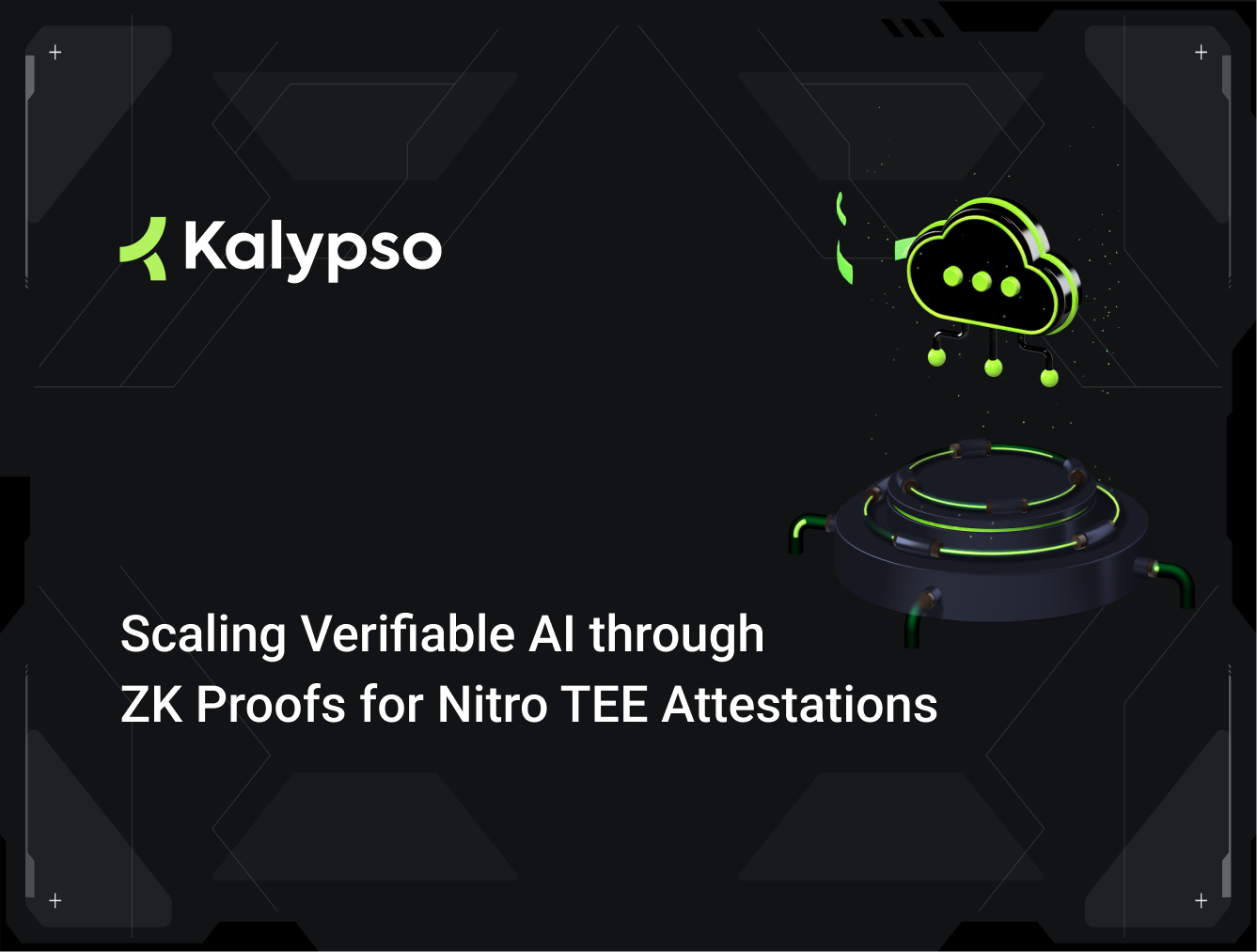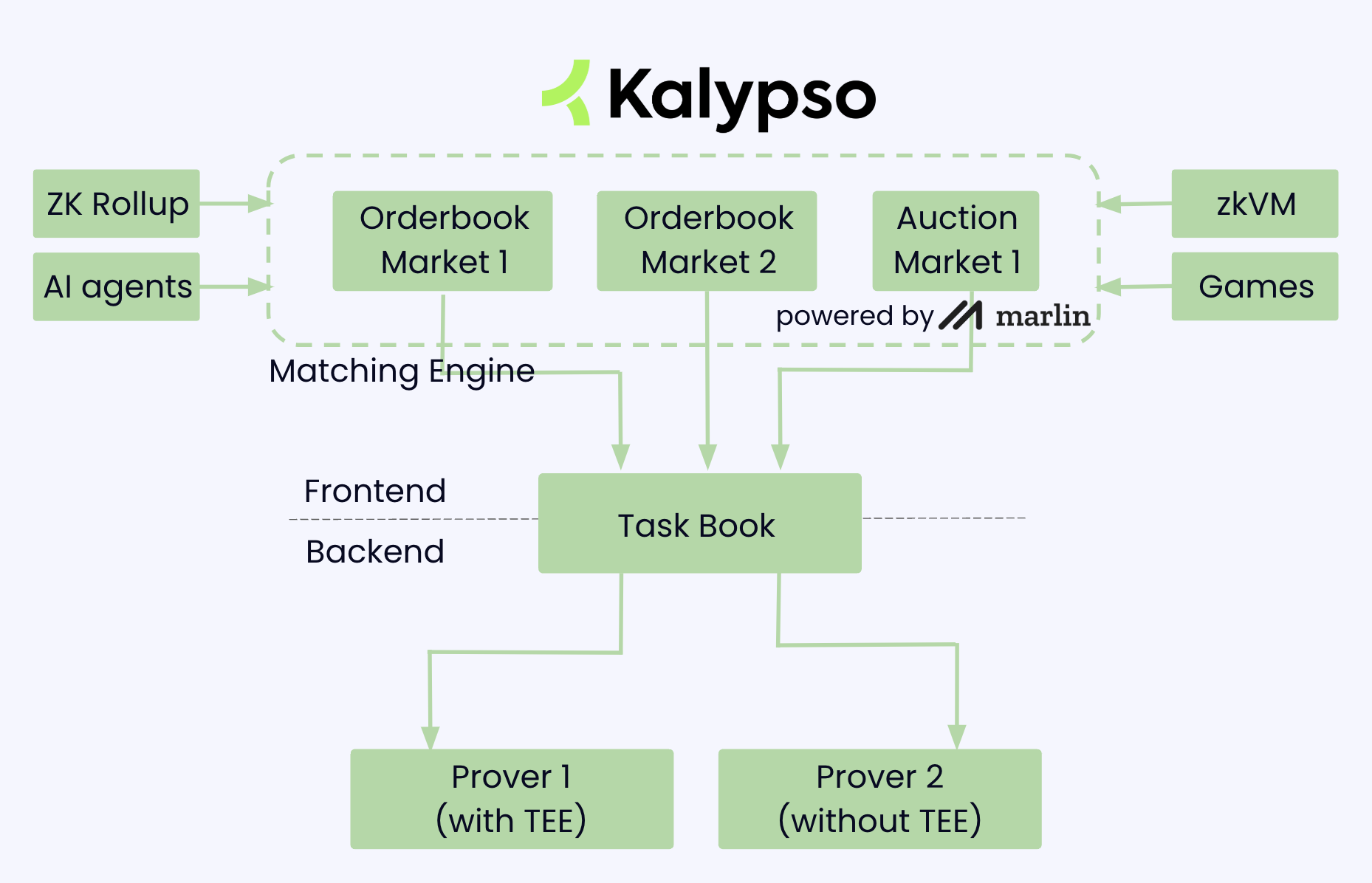Scaling Verifiable AI through ZK Proofs for Nitro TEE Attesations

Trusting AI agents in Web3 just got a lot easier—and cheaper. Kalypso launched a game-changing solution for AI agent verification on the blockchain. The new Nitro Enclave attestation verification market slashes the gas costs of verifying AI agents by 200x, making trustless AI verification practical for AI agents, developers and DAOs.
The challenge of trusting AI agents
As AI agents become more prevalent in DeFi and on-chain governance, a critical question emerges: how can we trust their computations? Developers are turning to Trusted Execution Environments (TEEs) to run their agents securely. TEEs like Intel SGX, AMD SEV, and AWS Nitro Enclaves provide hardware-level isolation, ensuring both confidentiality and integrity of AI agent operations.
However, there's a catch: verifying TEE attestation certificates on-chain has been prohibitively expensive. These attestations - which prove that an AI agent ran in a genuine TEE with the correct code - cost around 75M gas to verify on-chain. This massive gas cost has effectively blocked the adoption of verified AI agents in production systems. Projects in the space have come up with approaches like attesting a TEE once and assuming all compute within that specific TEE to be verifiable. While in theory, it makes sense but we don’t trust, we verify.
Kalypso solves this by taking an innovative approach: instead of verifying attestation certificates directly on-chain, it generates a zero-knowledge proof of the attestation. Verifying this ZK proof costs only 300K gas - a 200x reduction that makes trustless AI agent verification economically viable.
The attestation verification market
Kalypso achieves this reduction through a decentralized marketplace where hardware providers compete to generate ZK proofs of TEE attestations efficiently. Here's how the system works:
- An AI agent runs inside a TEE, which generates an attestation certificate
- The attestation needs to be verified on-chain to prove the AI agent executed correctly
- Instead of submitting the attestation directly, it goes to Kalypso's marketplace
- An operator generates a ZK proof for the attestation using optimized RISC-0 circuits
- This proof is submitted on-chain for verification at a fraction of the gas cost
By decentralizing proof generation, Kalypso ensures efficiency and scalability while maintaining trust.
Addressing developer concerns
As a developer, you might be wondering, "This sounds great, but what about the risks?"
- Is Kalypso as a marketplace reliable? Will it always be available?
- How can I trust sensitive data won’t be tampered with?
- What about performance? Is it cost-effective?
- How secure is the network overall?
These are all valid concerns, and Kalypso addresses them effectively:
- Decentralized marketplace: Kalypso operates as a two-sided marketplace connecting proof requestors (developers, AI agents, DAOs) with proof generators (participants with hardware like GPUs, FPGAs, or ASICs).
- Secure data handling: A standout feature is its ability to generate zk-proofs within a Trusted Execution Environment (TEE), ensuring sensitive data remains secure and tamper-proof.
- TEE based matching engine: Kalypso leverages the Marlin TEE network to manage low-latency order matching while securely handling sensitive data and accommodating proof request preferences.
- Performance optimization: Developers can optimize for cost, time, or a balance of both. Kalypso also employs custom RISC-0 circuits and GPU acceleration for faster proof generation.
- Robust security: The marketplace integrates with Symbiotic for added security, allowing the use of assets like stETH and wBTC as collateral, enabling cross-chain interoperability, enforcing slashing mechanisms, and fostering a diverse provider ecosystem to avoid centralization.
Ready to get started? Generate zk-proofs for your AI agent running within a TEE today!

Opportunities for Hardware Providers
As a hardware provider, you might be asking:
- What hardware is required?
- How does staking work?
- What are the rewards?
- How can I participate?
Here’s how you can get involved:
- Hardware requirements: You’ll need a setup with at least 8 vCPUs, 32 GB of memory, and an NVIDIA GPU (RTX series) with 12GB VRAM or more. Cloud options like Amazon EC2 G4dn, GCP G2 VMs, Hetzner dedicated servers, and OVH Scale-GPU series are also supported.
- Staking process: The marketplace runs on Arbitrum One, utilizing POND tokens for staking. Hardware providers also stake through Symbiotic on Ethereum using wstETH, wBTC, or POND. This dual staking system ensures both security and decentralization, requiring providers to stake in both systems.
- Rewards structure: Providers earn points for successful proof generation, which are split between the operator and the staking vault based on the operator’s commission rate. To maintain integrity, Kalypso includes a slashing mechanism for failed or incorrect proofs. While slashing is initially set to zero, it is ready to be implemented as the platform scales.
- Getting started: Follow the setup guide or visit app.kalypso.org to register and begin.
Excited to contribute? Set up your hardware and join the Kalypso ecosystem today!
Impacting the space
Kalypso's launch represents a significant step toward practical, verified AI agents in Web3. By making attestation verification affordable, it opens the door to new use cases in DeFi, governance, and beyond.
For developers and DAOs, this means being able to deploy AI agents with cryptographic guarantees of their behavior. Rather than paying massive gas fees to verify TEE attestations directly on-chain, they can leverage Kalypso's ZK proof system for the same security guarantees at a fraction of the cost. For users, it means greater confidence in AI-driven systems, backed by hardware-level security and economic incentives.
Looking ahead
Kalypso's roadmap focuses on several key areas:
- Support for additional TEE types beyond Nitro Enclaves
- Adding support for additional circuits
Kalypso is actively building a community of developers and infrastructure providers. Those interested in running verification nodes or integrating verified AI agents into their protocols can find more information at docs.kalypso.org